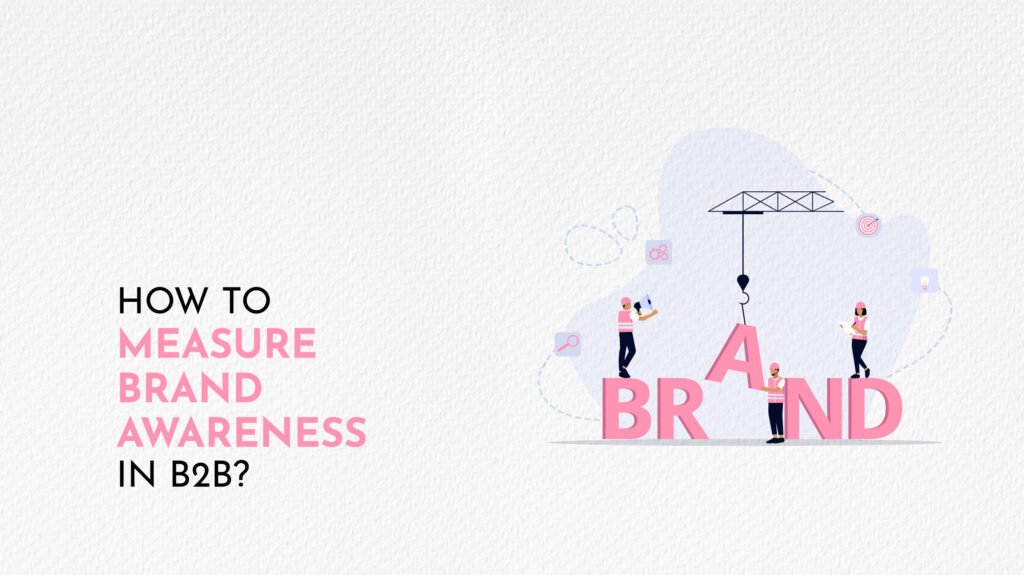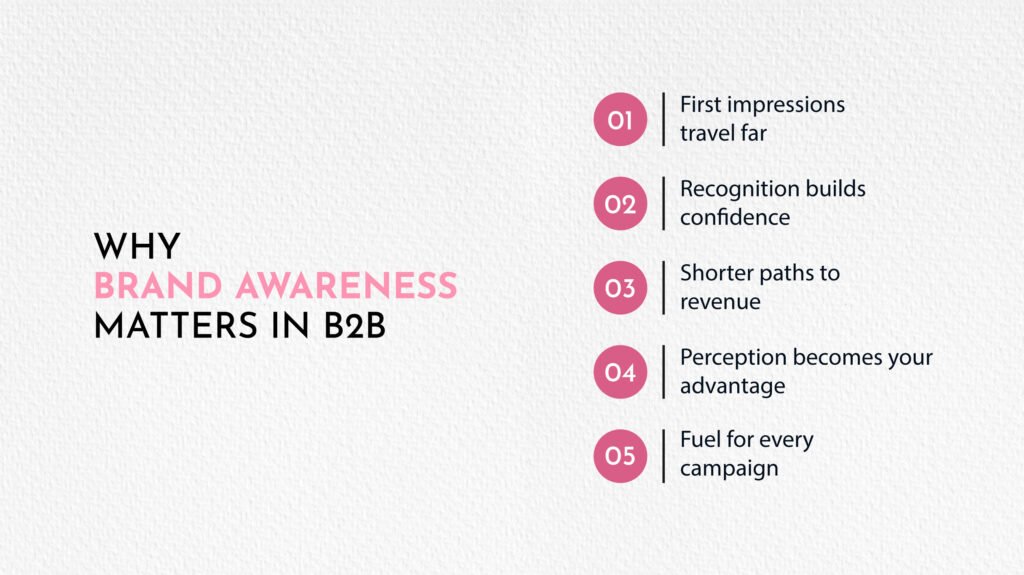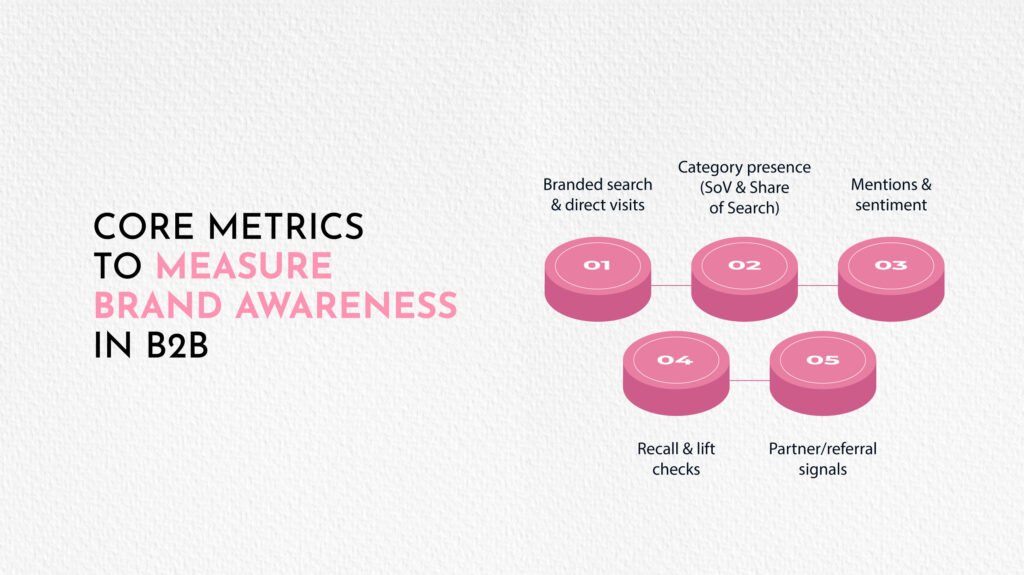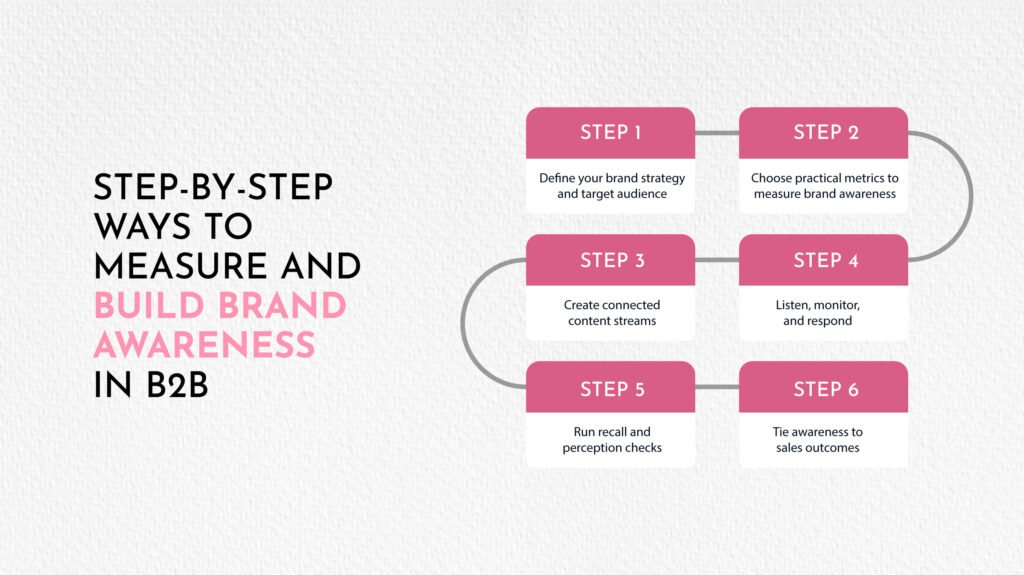
When I joined my first B2B company, everyone believed we had a strong reputation. We showed up at trade shows, published reports, and spent heavily on ads. But when I asked a few prospects what they knew about us, most paused some even thought we were a competitor. That’s when I realised we were spending money without knowing if anyone actually remembered us. That’s the heart of how to measure brand awareness in B2B.
It’s not about being loud, it’s about being remembered. Real B2B brand awareness metrics go beyond vanity numbers and show if your name sticks with the right audience. You track visibility, recognition, and recall all tied to revenue, not impressions.
Using brand awareness measurement for B2B companies means mixing data and feedback: web analytics, surveys, and social tracking. Then, through B2B brand visibility tracking, you see how often your brand shows up where buyers spend time. That’s how you turn awareness from a vague idea into something measurable and meaningful in long B2B cycles.

Brand awareness matters in B2B because people don’t buy what they don’t recognise. In long buying cycles, familiarity wins meetings, and trust closes deals.
In most B2B environments, buyers narrow choices fast. If your brand doesn’t ring a bell in that short list, you’re invisible before the pitch even starts.
When a decision involves finance, legal, and IT teams, a strong brand reduces risk. Familiarity feels safe; that’s why it shapes B2B purchasing decisions more than price sometimes does.
Buyers who already know the name convert quicker. Awareness trims weeks off the funnel for B2B companies with consistent visibility.
Once people are aware of your brand, they compare you on value, not existence. That shift in brand perception changes how prospects listen and what they expect.
Awareness makes ads cheaper and outreach warmer. Each marketing campaign performs better when the audience recognises who’s speaking.

In B2B, how to measure brand awareness in B2B comes down to tracking what proves memory and intent, branded search, direct visits, category share of voice, and recall and not just impressions
Nielsen’s analysis (summarized by MarketingCharts found brand recall drives ~38.7% of total brand lift memory beats pure exposure in top-funnel performance.
Watch queries for your brand name and type-in traffic. If both trend up, more buyers already know you, clean metrics to measure brand awareness without survey bias. So, pair this with B2B brand awareness metrics like returning users and branded CTR to see intent forming.
Track share of voice for B2B brands across PR, organic, and paid, and compare branded search volume to competitors. These show how loud you are and where you’re losing ground. Use brand awareness measurement for B2B companies quarterly so shifts line up with campaigns and seasons.
Log every brand mention and the tone around your posts and press. Social threads, forums, analyst notes, these reveal how people talk around your brand after they hear from you.
Run short aided/unaided surveys after big pushes. If more prospects remember your brand unaided, awareness work is landing; if aided rises but unaided stalls, the message isn’t sticky yet.
In B2B, credibility travels through others. Co-marketing, backlinks, and events with peers show awareness spreading beyond your own channels.
Use numbers to see reach and memory, and use human feedback to learn why your brand sticks or doesn’t. Just knowing about how to measure brand awareness in b2b is not enough, you should also try to understand both the quantitative and qualitative metric.
Quant (what to count)
These are your clearest brand awareness metrics. If buyers come back on their own, you’ve moved beyond exposure into recognition.
Count category coverage and compare to competitors. Treat it as a leading brand awareness measure then check if pipeline follows.
When more people click the result with your brand name, awareness is turning into intent. Track by market/segment so small wins don’t get lost.
Analyst links, guest features, and co-webinars indicate third-party trust. In B2B, that trust is often the bridge into shortlists.
Qual (what to learn)
Unaided: “List vendors for [problem].” Can they recognize your brand without prompts?
Aided: “Have you heard of [brand]?” If aided rises but unaided lags, your name is familiar but not top-of-mind. That’s fixable with messages and repetition. Use this to keep calculating B2B brand recall each quarter.
Ask what your brand is known for, and what buyers wish it did better. This is core B2B brand perception measurement and it tells you which promise lands versus what needs proof.
Read verbatims around your brand from events, calls, and socials. Tally themes buyers repeat. Those themes should appear in your decks and on your site, not just in a social thread.
Add one question at key touchpoints: “How did you first hear about us?” Over time, you’ll see which channels build steady awareness versus one-off spikes.
Use solid scorecard for brand KPIs, simple ladder benchmarks for each market, quarterly review loop to show the brand improving.
1) One-Page KPI Scorecard (fill monthly/quarterly)
Branded search growth
Direct traffic share
Share of Voice for B2B brands
Unaided recall
Partner / referral volume
Use metrics like conversion-to-meeting from branded leads to confirm these are moving pipelines, not just traffic.
2) Benchmark Ladder (by region/segment)
Baseline → Target → Actual → Variance → Action.
Keep a 3-month rolling baseline so small b2b samples don’t skew trends. Title the grid brand awareness benchmarks for B2B and keep it identical across markets for clean roll-ups.
3) North-Star + Two Guards
4) OKR Example (quarter)
5) Cadence & Owners
Name the packet KPIs for B2B brand awareness and circulate one page only.
6) Top-Funnel Lens
Pair SoV with branded search to keep measuring top-of-funnel brand equity. If SoV rises but search stalls, fix channel mix; if search rises but recall lags, fix the line.
7) Quick Diagnostics

Measuring and improving brand awareness in B2B isn’t a list of things you do, it is an on-going collection of data, perception and message control. Read below to learn how to measure brand awareness in b2b.
Step 1: Define your brand strategy and target audience
The first step to properly clarify what exactly your brand means and who are your targeted clients. In b2b marketing, decision-makers are diverse; CFOs care about ROI, IT cares about risk. Document the promise your brand makes to each group and how you’ll keep it. A strong brand strategy keeps every message, campaign, and outreach anchored.
Step 2: Choose practical metrics to measure brand awareness
Forget bloated dashboards. Pick data that links awareness to growth. Combine branded search and SoV for reach, recall surveys for memory, and referral traffic for trust. Use B2B brand awareness tools or analytics suites to stay consistent. Add one or two metrics like branded conversion rate or inbound meeting volume, the numbers leadership understands.
Step 3: Create connected content streams
Every marketing campaign should reinforce the same story. Mix content marketing (blogs, reports) with social media marketing for reach and credibility. Use SEO to plant phrases buyers repeat in calls; that’s how a b2b brand awareness engine compounds. Check each asset against your message so you never dilute the voice.
Step 4: Listen, monitor, and respond
Listening to people’s comments is important. So, appoint one listening tool to track what people say across forums, LinkedIn, and press. This isn’t vanity monitoring, it’s measuring brand tone and perception in motion. When sentiment slips, fix the message early. Active listening is the only way to manage brand awareness effectively before it becomes a problem.
Step 5: Run recall and perception checks
Test aided and unaided recall quarterly. Keep it short like five questions max. Look for changes in what people associate with your brand and whether they can explain your value in their own words. That feedback tells you if your awareness work is building memory or just impressions.
Step 6: Tie awareness to sales outcomes
Every awareness lift should echo in the pipeline. Match recall and SoV gains to branded lead creation. When awareness doesn’t translate, revisit your target audience or distribution plan. The goal isn’t traffic, it’s recognition that leads to consideration.
The hard part isn’t collecting data, it’s proving that brand awareness moved real prospects closer to choosing your brand. So when you are trying to learn how to measure brand awareness in b2b, you will also need to understand the challenges associated with it
Deals touch ads, events, partners, and sales. Credit gets muddy fast. Take a look at metrics, like branded search + Share of Voice for a sense of direction then see if branded opportunities and win‑rate are ticking upward each quarter.
Many b2b brands sell to a few thousand buyers across the globe. Samples are thin, so a single spike can distort results. Stabilise with rolling three-month baselines and compare against brand awareness benchmarks for B2B rather than week-to-week changes.
Aided awareness can rise while unaided stalls. That means people “know of” the brand but can’t name it cold. Fix with tighter positioning and repetition to the target audience; re-test with brand lift measurement B2B after campaigns.
Mentions rise, but tone may slip. Use one listening tool consistently so sentiment scoring is comparable. Pair it with brand awareness analytics for B2B volume, velocity, and topic mix, not just a single score.
What’s easy to track (paid, search) gets over-valued; what’s harder (PR, partners, events) gets ignored. Balance the view with partner/referral reporting and a light survey layer. That keeps the full approach to brand awareness intact.
Traffic grows, but recall doesn’t. The story is unclear. Tighten the line in ads, site headers, and content marketing assets so buyers can repeat it. In b2b marketing, if they can’t retell it, they won’t remember it.
Too many dashboards, no single truth. Standardise on two or three tools like GA4 (branded/direct), GSC (queries), and Brandwatch/Mention (SoV and brand mentions). That’s enough to measure awareness without drowning the team.
Awareness alone won’t grow the pipeline. Close the loop: run nurture, demos, and partner plays that build brand awareness into consideration and increase brand awareness into meetings. Track the handoff with simple “How did you first hear about us?” fields so the numbers tell one story.
In B2b, awareness grows slowly. It’s the small signs that matter, a prospect who recognises your name, a partner who mentions you first, a search that brings people straight to your site. That’s what real awareness looks like.
Learning how to measure brand awareness in B2B helps you see those signs clearly. You stop guessing who knows you and start tracking it. Each visit, recall survey, and referral tells you where your story is landing and where it still needs work. When that pattern starts repeating on its own, you’ve done more than run campaigns, you’ve built a brand that people remember without being asked.
In B2B, awareness builds slowly. Track branded search, direct traffic, and share of voice over a few months instead of weeks. Add short recall surveys to see if your brand is remembered even before a deal begins. That’s the simplest proof of real brand awareness.
Stick with a small set that connects visibility to results; branded search, unaided recall, and referral traffic. These show how often buyers find, name, and recommend your brand. It’s the cleanest way to see how to measure brand awareness in B2B without drowning in data.
When inbound leads mention your company before you pitch, your awareness is working. Watch for rising branded opportunities and faster replies from partners or prospects. Those quiet signals often say more about a strong brand than any chart.